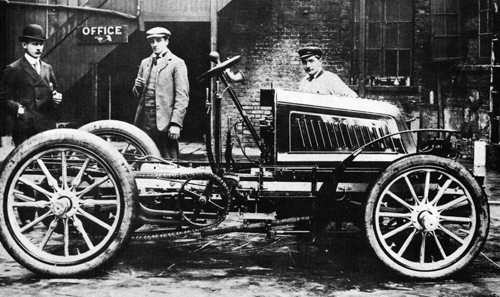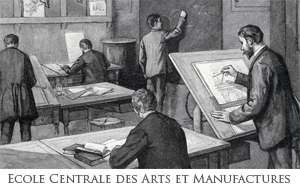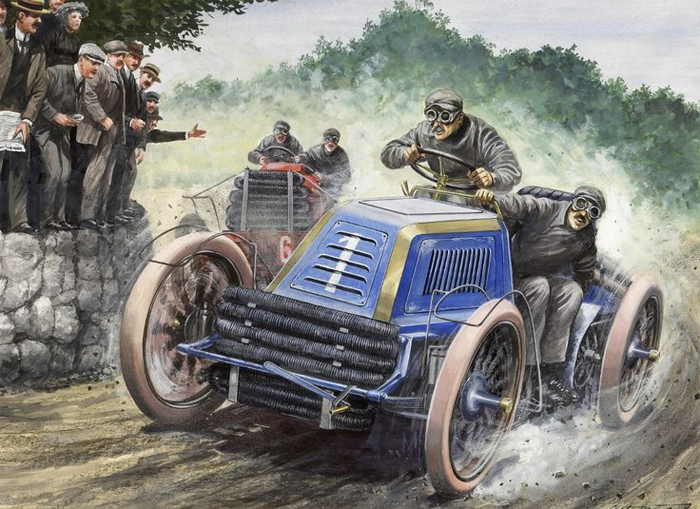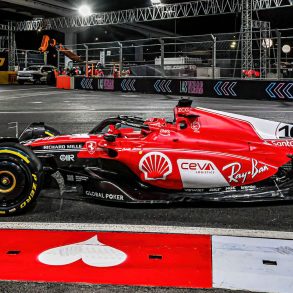Mors 60 HP
Car: Mors 60 HP/ Engine: 4 Cylinder In-Line / Maker: Mors / Bore X Stroke: 140 mm X 150 mm / Year: 1901 / Capacity: 9,236 cc / Class: Grand Prix / Power: 60 bhp at 950 rpm / Wheelbase: 99 inches / Weight: 2,220 lbs
In 1851 a company by the name of Mirand produced artificial flowers with wire stems. the machine to wrap paper around the stems was the key development and could be adapted to wrap insulation around electrical wire used in doorbells and from there the company entered the electrical business. In 1874 Louis Mors acquired the business which by now had branched out to make electrical equipment for railway signaling. Mors two sons, Louis and Emile took over the company in 1880. Both had graduated from the Ecole Centrale des Arts et Manufactures. In 1886 they hired a 22-year old draughtsman by the name of Charles-Henri Brasier. One of his first tasks was to design a steam tricycle with a single kerosene heater for a client of Mors .
The Mors brothers were well aware of current developments in motor cars and in 1892 Louis bought a car from Panhard et Levassor, their future rival but it wasn’t until three years later that they would try their hand at the automobile business. Brasier their chief designer produced a car with the engine in the rear with power transferred via a belt and pulley transmission. His next car utilized a V 4-cyclinder engine with a central crankshaft and electric ignition. While Mors pioneered the V-4 configuration they appeared to have abandoned it later in favor of inline 4-cylinder engines. In 1898 the Mors firm incorporated as Société d’Electricite et des Automobiles Mors with a factory at rue du Théâtre in Paris. Georges Huillier and Brasier would serve as the firms initial managers. Georges Terrasse work with Brasier in the design department.
Mors was one of the earliest car manufacturers to take part in racing. The Mors brothers, both engineers were strong believers in the technical and promotional benefits of automobile racing. Much of racing at the turn of the century was a battle between Panhard and Mors in the heavy car class. At the 1999 Tour de France six of the first seven cars were Panhards but back in eighth and ninth were two Mors driven by Alfred “Levegh” Velghe and Belgian Camille Jenatzy. At the 1899 Paris-Saint Malo race Antony and Levegh came in 1st and 2nd for Mors.
Unfortunately ill health would force Levegh to retire. For the 1901 Mors’ new star, Henri Fournier, Charron’s former riding mechanic, driving a 60 hp Mors won the Paris to Bordeaux race at an average speed of 53 mph.
A month later at the Paris to Berlin race Mors entered a total of seven cars driven by Henri Fournier, Brasier, Gilles Hourgières, Charles Rolls, Antony, Foxhall Keene and Desmarest. Brasier passing a competitor, ran down a ten-year-old boy, Ernest Breyer, who by the side of the road was obscured by the automobile he was overtaking. Brasier: afterwards related that there was no time either to turn back to the center of the road, to warn the boy, or even slow up. Breyer died half a hour later. Brasier overcome with grief, stopped and waited aimlessly before resumed the race a half an hour later. Brasier would finish a disheartened fourth while Henri Fournier won again driving a 60 hp Mors. Brasier, himself soon stopped racing. In 1902 a change in rules stipulated a maximum weight of 1000 kilos in a vain attempt to reduce speeds. What it did reduce was almost any semblance of bodywork and ever lighter chassis. This 60 hp type Z was one of eight Mors entries for the 1902 Paris – Vienna motor race that also included the year’s Gordon-Bennett Cup event.
The 60 HP Grand Prix car was powered by a 9.2 liter Inline 4-cylinder engine, using magneto ignition and side valves it rated power of 60 bhp was reached at 950 rpm. The double chain drive chassis was made of wood with steel reinforcing plates. Rear brakes were applied by a hand lever, while a separate foot pedal operated a transmission brake. Contemporary reports stated the brakes were quite effective-until they became clogged with dirt and the oil drooling off the engine, at which point engine braking became the primary means of retardation. Even this was considered fairly conservative when matched against Panhard’s behemoth. The Mors’ secret weapon was the use of dampers or shock absorbers, two in the front and four in the rear for better handling and a mechanically efficient direct drive top gear to redress Panhard’s horse power advantage.
The first day of the three-day event, leading all 136 competitors, Henri Fournier famously roared past the organizers’ high-speed press train at over 70 mph trailing a huge plume of road dust. The race would turn out to be a disaster for the Mors cars when all but one of the Mors entries came to grief. Trouble with the new gearbox eliminated Fournier after he had averaged 71 mph from Paris to Provins. This lone surviving Mors was the car driven by Baron de Caters which placed 9th after 615 grueling miles racing over the arrow straight Routes Nationales of France, unpaved, potholed Alpine passes and the scorching, undulating roads of central Europe.
The race was dominated by light cars with the Renault of Marcel Renault coming in first. The Gordon Bennett Cup was famously won by Britain Selwyn Edge driving a Napier. In road racing the days of brute force were coming to an end and with that the great rivalry between Mors and Panhard that marked the beginning of the century would soon be over. In record setting however the 60 hp Mors would become the first petrol engined vehicle to take the world land speed record in the hand of American William K. Vanderbilt. He chose a model known as the Paris-Vienna, and made his successful attempt at Ablis near Chartres in August 1902. Vanderbilt’s time was two-fifths of a second better than that set up by the steam-driver Serpollet along the Promenade des Anglais at Nice.
Charles-Henri Brasier their gifted designer left to join Georges Richard while their leading driver, Henri Fournier, transferred his allegiance to the new Hotchkiss company, which then added insult to injury by enticing Brasier’s colleague, Georges Terrasse, to join them as designer, and while there he promptly created a racing Hotchkiss that was more Mors than the genuine article.
Mors did not even bother with the 1905 Gordon Bennett, raced not at all in 1906 and made only token appearances in 1907 and 1908. Mors proud racing history culminated in a failure-strewn attempt at the 1908 French Grand Prix which even the presence of Camille Jenatzy could not rescue. During World War I Mors produced a light armored vehicle with a single compartment of 5 mm steal plate that would only protect against rifle bullets. The car was used on both fronts with the Belgian armored squadron, the Corps Expeditionnaire des Autos-Canons-Mitrailleuses Belges, deployed on the Russian front. But the war also ruined Mors’ plans for a racing comeback. The firm was eventually taken over by Citroen after a dispute over the possibility of liquidation with other board members.


















